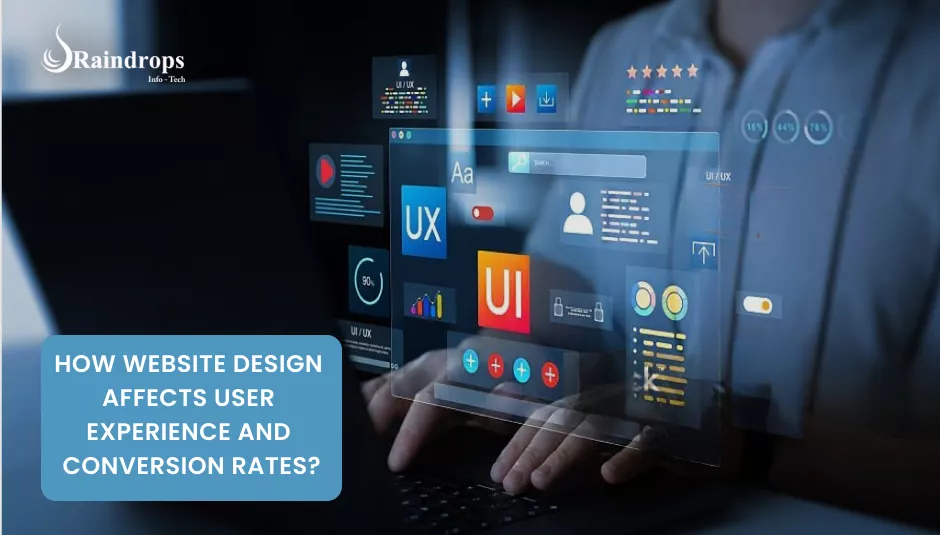Ever landed on a website and clicked away within seconds? Maybe it was too slow, confusing, or just didn’t “feel right.” That’s exactly what this article is about.
If you’re running a business or managing a website, one thing you can’t afford to ignore is your website design. Why? Because it directly impacts your user experience (UX) and your conversion rates: the two things that can either grow your business or hold it back.
So let’s break this down in simple, real terms.

What Is Website Design and Why Does It Matters?
Let’s clear one thing up, website design is not just about making your website “look good.” Sure, looks matter, but that’s just the surface.
Real website design is about how your website works. It’s the structure. It’s the speed. It’s how easily someone can find what they’re looking for.
Think of your website like a shop.If it’s messy, slow, or confusing, people will walk out: fast. But if it’s neat, fast, and easy to explore, they’ll stay longer… and probably buy something.
That’s the impact of web design on conversion rates, it can literally decide whether you make money or lose visitors.
A well-designed website:
-
Loads quickly (because no one likes waiting)
-
Works smoothly on both phone and desktop
-
Has clear menus and buttons
-
Shows people exactly what they need, without making them hunt for it
In short:
Good website design = A great first impression
Bad website design = Missed chances, lost trust, and high bounce rates
And here’s where the real magic happens. When your website design improves, user experience improves too. And that brings us to…
What Is User Experience (UX)?
User experience (UX) is all about what someone feels when they use your site. Is it easy? Is it smooth? Or does it make them want to scream and close the tab?
Here’s a quick test:
-
Can a visitor find what they need in less than 5 seconds?
-
Can they move from one page to another without getting lost?
-
Can they click a button without zooming in, squinting, or getting annoyed?
If the answer is “yes,” you’ve got a solid user experience.
If not, you’ve got a problem.
How website design affects user experience is huge. Even things like font size, button placement, and white space can make someone feel comfortable or completely overwhelmed.
And when people feel good using your site, guess what? They’re way more likely to stay, trust you, and take action.
What Are Conversion Rates?
Let’s break this down super simply. A conversion is when a visitor does something you want them to do on your website.
Like:
-
Buying a product
-
Filling out a contact form
-
Booking a call
-
Subscribing to your newsletter
Here’s how to calculate your conversion rate: (Number of conversions / Total visitors) x 100
So, if 10,000 people visit your site and only 100 of them sign up or buy something? That’s a 1% conversion rate and that’s a sign something might be wrong with your design or user flow.
This is why the impact of web design on conversion rates is massive. A confusing layout, slow loading speed, or hidden buttons can easily kill your conversions.
Now imagine if better design helped you go from 1% to 3%. That’s 3X more customers. Without spending a single extra rupee on ads.
How Website Design Affects User Experience and Conversion Rates?
This is where things really start to matter. You already know that website design and user experience go hand in hand. But let’s break down exactly how your design choices affect how people use your site and whether they take action or bounce off.
When your site is hard to use, people leave. When it’s easy and enjoyable, people stay. Simple.
So let’s look at the specific parts of your website that can make or break the user experience and have a direct impact on conversion rates.
a. Navigation & Usability

When someone lands on your website, they should be able to find what they need within a few seconds. If they can’t, they’ll leave.
Clear and simple navigation is one of the most important parts of a good user experience. If your menus are confusing or cluttered, people will get frustrated and stop exploring your site.
Here’s what works:
-
Keep the main menu visible and easy to read
-
Use clear labels like “Home,” “Services,” “About,” and “Contact”
-
Avoid too many items : too much choice can be overwhelming
-
Add a search bar for quick access to content
Easy navigation leads to smooth browsing, which means visitors stay longer and are more likely to take action. This is how website design affects user experience and conversion rates directly.
b. Page Load Speed

No one likes a slow website. In fact, if your site takes more than 3 seconds to load, more than half your visitors will bounce. Yep, they’ll leave before they even see your content.
Slow speed hurts your user experience and your conversion rate.
Here’s what you can do:
-
Compress images so they load faster
-
Use reliable and fast hosting
-
Avoid unnecessary plugins or scripts that slow things down
Think of it this way: A fast website feels modern, smooth, and trustworthy. And that builds confidence which leads to action.
c. Mobile Responsiveness

Let’s be real: Most people today browse websites on their phones.
Major traffic comes from mobile devices. So if your site doesn’t look good or work properly on a phone, you’re instantly losing a big chunk of your audience.
That’s why mobile-friendly website design is non-negotiable.
Here’s what to check:
-
Is the text readable without zooming in?
-
Are buttons and menus easy to tap?
-
Does the layout adjust to fit smaller screens?
When your website design works great on mobile, you’re not just improving user experience, you’re protecting your conversion potential.
d. Visual Hierarchy

Not everything on your site should scream for attention. The most important elements like your CTA (Call to Action) buttons or product highlights need to stand out clearly.
This is where visual hierarchy comes into play.
Good design uses:
-
Larger fonts for headings
-
Bold colors for important buttons
-
White space to make content feel clean and uncluttered
When users land on your page, they should know exactly where to look next. If everything looks the same, they’ll get overwhelmed and bounce. A smart layout guides people and that improves both user experience and conversions.
e. Trust Signals

Would you give your credit card info to a sketchy-looking site? Nope. And neither will your visitors.
That’s why trust is a huge part of good website design.
Here’s how to build trust visually:
-
Add real testimonials or reviews from happy customers
-
Show certifications, awards, or media mentions
-
Use security badges or “100% safe checkout” icons on payment pages
-
Include a clear “About Us” and contact info
Trust signals make users feel safe. And when people trust you, they buy from you. Simple as that.
f. CTAs (Calls to Action)

This is the moment of truth. When someone clicks “Buy Now,” “Book a Demo,” or “Get in Touch.”
Your CTA buttons are the bridge between interest and action. But if they’re hard to find, boring, or confusing, people won’t click.
Strong CTAs should be:
-
Clear and action-focused (“Start Free Trial,” “Get a Quote,” “Let’s Talk”)
-
Visually bold (use contrast to make them pop)
-
Placed where people naturally scroll and pause, like at the end of a section or next to product info
The impact of web design on conversion rates often comes down to one thing: whether your CTA stands out and makes people feel confident clicking it.
Quick Simple Tips to Improve Website Design Today
You don’t need to do a full redesign to see better results. Start with these small but powerful changes:
-
Use white space properly : Don’t try to fill every corner of your screen. Empty space helps people focus on what matters. It makes your site easier to read and less overwhelming.
-
Stick to 2–3 main colors and fonts : Too many colors or font styles can be distracting. A clean, consistent look builds trust and keeps your website looking professional.
-
Make your CTA buttons stand out : Your “Buy Now,” “Get Quote,” or “Contact Us” buttons should be easy to see and click. Use bright colors and clear text. Make sure they work well on both mobile and desktop.
-
Test and improve your page speed : A slow website hurts user experience and kills your conversion rate. Use tools like Google PageSpeed Insights to check loading times and follow their suggestions to fix issues.
-
Get feedback from real users : Ask real people to use your website and tell you what’s confusing or hard to find. Their input can show you what needs fixing, especially things you might have missed.
These small changes can make a big difference in your user experience and your conversion rates.
Your Website Design Affects Your Business Results
Your website is more than just a place online. It’s the first impression people have of your business. And it can either bring you leads or lose them.
Good design = Better experience = More conversions.
If your website isn’t performing, it’s time to take design seriously. Don’t let your visitors bounce, give them a reason to stay and take action.
Ready to Transform Your Website?
Let Raindrops Infotech help you build a high-performing website that people love to use. We don’t just make things look good, we focus on better user experience, faster speed, and higher conversion rates. Schedule a free consultation with us now and let’s turn your website the best in the business.

